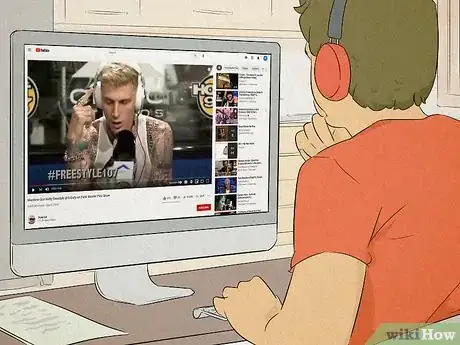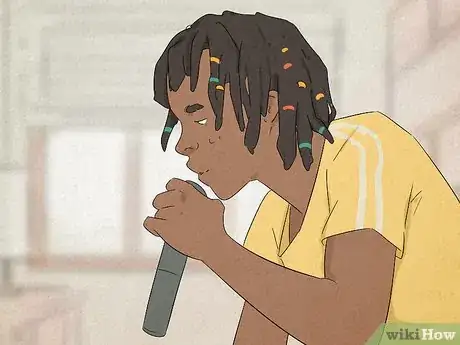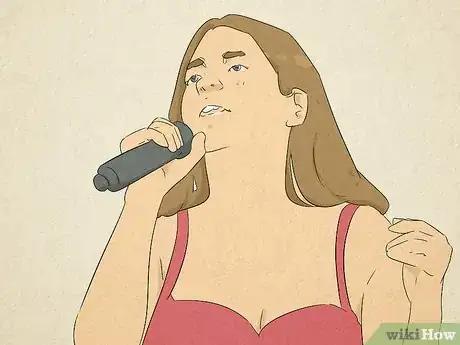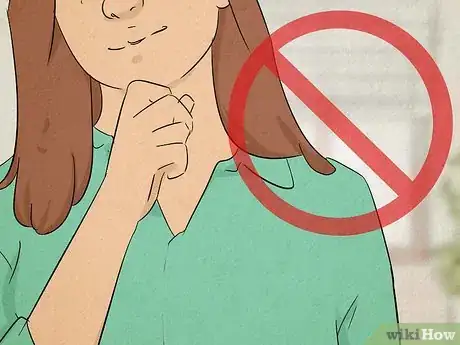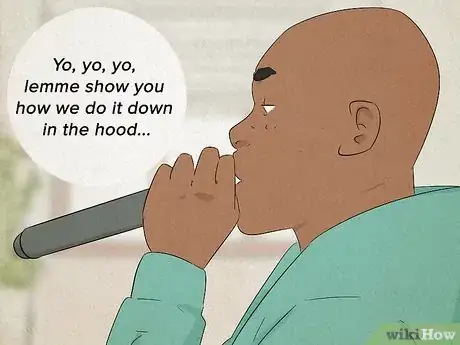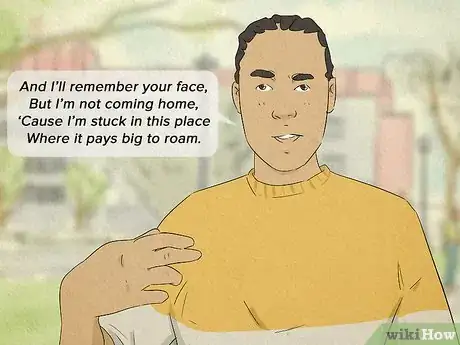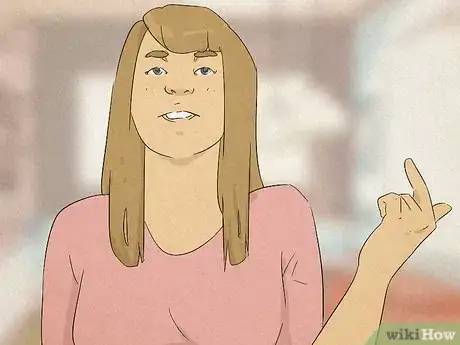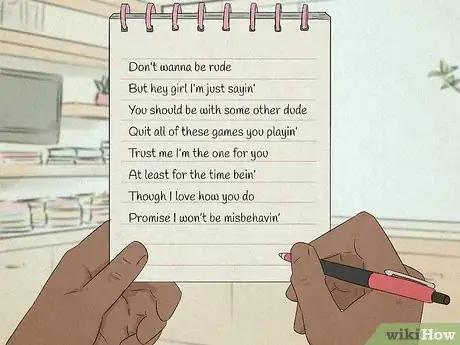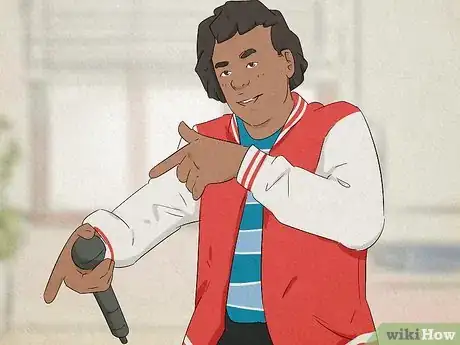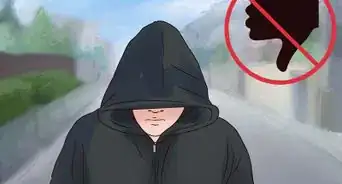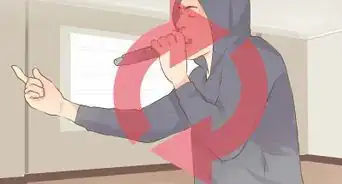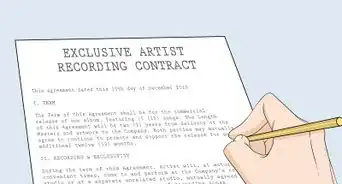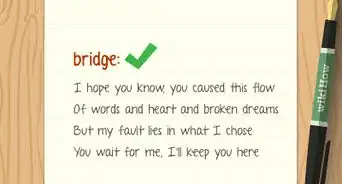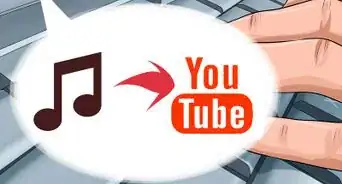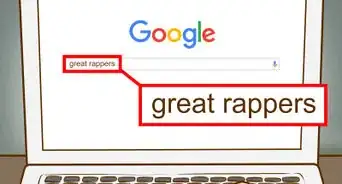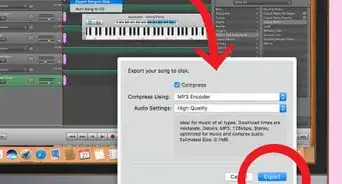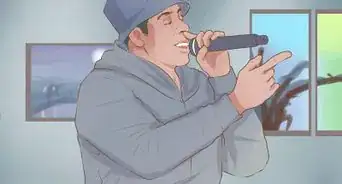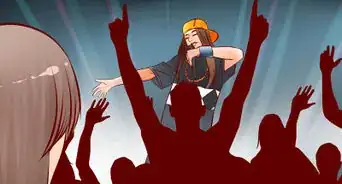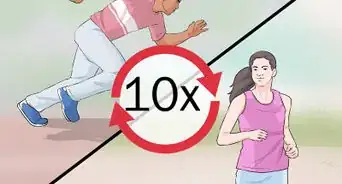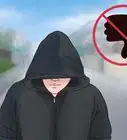X
wikiHow is a “wiki,” similar to Wikipedia, which means that many of our articles are co-written by multiple authors. To create this article, 160 people, some anonymous, worked to edit and improve it over time.
This article has been viewed 1,303,463 times.
Learn more...
Freestyle rapping can be overwhelming at first, but following these simple steps will get you moving toward the mic in quick fashion.
Steps
Part 1
Part 1 of 3:
Rhyming Your First Rhymes
-
1Listen to lots of freestyling. Unwritten freestyle raps from straight off the dome will probably be somewhat rougher and more unpolished than the tracks you've been listening to, but they can also be more unpredictable and thrilling. Freestyle has its own feel and listening to other rappers freestyle is a good way to learn the tricks of the trade.
- Check out live battles or hip-hop freestyle competitions if your town offers them. Go and listen. This can also be a good way to meet other aspiring rhymers and make connections.
- YouTube is a great resource for videos of freestyle battles from all eras. Everything from Notorious B.I.G. rapping on a street corner at the age of 17 to classic Eminem battles to the smattering of underground rappers free-styling over a new Kanye West track are good research.
-
2Start with a beat. Get a beat without any words online or loop the instrumental of a song you love on YouTube, and let it play for a while. Get a feel for the beat. If you've got a rhyming verse already written, start there, or try writing new rhymes as you listen to the beat. Repeat it over and over until you've started to get a feel for the cadence of the song and how your flow fits into it. Don't worry if you lose the beat at first.[1]
- Begin with the downbeat. The vast majority of rap music is written with a traditional four-four time signature, also known as Common Time. This means that every measure will have a strong downbeat at the beginning: ONE-two-three-four-ONE-two-three-four. Start on that beat.
- Often, there will be blank space on tracks while the rapper is waiting to come in. If you don't have access to instrumentals or YouTube, you can use those spaces to practice.
Advertisement -
3Improvise. Once you've gotten a feel for the beat and you've exhausted your rhymes, take tentative steps toward a freestyle. Repeat a line you've already written but make yourself come up with a new rhyme for the second half of the rhyme.[2]
- Don't worry if what you're saying doesn't make sense at first. You're trying to get a sense of the feel of the beat and making your mind create rhymes on the fly. Nobody's listening anyway.
-
4Stop thinking. If you think too much about your next line you are going trip up and stumble over the line you're on. Practice letting your mind flow freely from one thought to the next. The best freestylers are relaxed and comfortable with the beats they're working with. If it doesn't seem to be coming, don't try to force it. Listen to the beat and try to write some rhymes to it to get started, or try out another beat.[3]
- Lock yourself in your bedroom or your basement or your garage. Nobody else needs to hear your practices if you don't want them to. Putting in the hours by yourself will ensure that your debut for listeners will be all the more spectacular.
-
5Keep flowing. Even if you make a mistake, train yourself to keep going. If you stutter over a word or two, spit something like, "Did I stutter? My flow should be soft like butter." Rap is like comedy: the timing is everything.[4]
- Experienced freestylers often have back-up lines, which serve as the fire extinguisher in the red box that's mounted on the wall of rap and used only in emergencies. This is a line, or a phrase that you use when you can't think of anything else but need to buy some time to go back out on a tangent. The better you get at freestyling the smaller this phrase will become. Really good freestylers will use a one syllable filler line like "Yo" or "Matter of fact". Eventually, your back-up filler line will be something that you can start saying without realizing it.
Advertisement
Part 2
Part 2 of 3:
Developing Your Freestyles
-
1Turn your starter lines into punch lines. The best way to increase the speed of your flow and improve your freestyle game is by reversing the way you work. If you've been practicing by starting with a line you've written and then moving away from it by improvising, make yourself start with a new line and work toward that line you've already written and you know is good.
- This is where those rhyming clusters will help you. If you've got an especially good punch line, practice by rhyming as many different things as you can with it. Exercising around that line will make sure that you've got lots of different options the next time you're improvising.
-
2Play with words. In the beginning, it makes the most sense to freestyle around hard end-rhymes like "bear" and "chair," but eventually those may start becoming stale and leading you into clunky rhymes.[5]
- Slant rhymes share consonant sounds without necessarily sharing vowel sound directly. "Vowel" and "bowl" for example, are slant rhymes.
- Assonance and alliteration are sound-devices in which vowels and consonants, respectively, are repeated in a line. Edgar Allan Poe in his famous poem "The Raven," uses both at once: "the silken sad uncertain rustling of each purple curtain" repeats "s" sounds and "ur" sounds.
-
3Develop similes. Like Cassidy's line about "Goin' platinum like Sisqo hair" or Raekwon's line "I get deep like a baby seal," a simile that unexpectedly and creatively compares one thing to another thing is a cornerstone of freestyle hip-hop and poetry alike.
- In a notebook, brainstorm different endings for similes to pull out of your hat. Fill a couple pages with "like a _______" and experiment by combining them all with the same line: "My flow is cold / like a rainstorm" or "My flow is cold / like a sperm whale" leave very different impressions. You may surprise yourself.
-
4Be yourself. Unless you're Rick Ross, it will be hard to pull off any grand claims about your global cocaine trafficking empire if you're a teenager from the suburbs. Rhyme about what you know and be honest. The most important thing (and the thing other freestylers will recognize) is when your skill is backed up with perspective and honesty.
- While it's a good way to develop and learn, repeating other rappers lines or styles is considered extremely taboo in the freestyle world, and will need to be dispensed with as soon as you feel comfortable.
-
5Freestyle in front of some friends. Once you feel relatively comfortable, invite some understanding friends to watch and critique your skills. This will help you get used to freestyling in front of people and they'll be able to offer suggestions and encouragement.
- Incorporate your audience into the fun by having someone pick a beat for you to rap over will get you ready for the possibility of competitions or battles if you're interested in giving one a shot. You can also have a friend pick a topic, or an item in the room, or a word and say it out loud. Start freestyling about that topic, item, or word. This forces you to keep on your toes because your friends are the ones leading the direction your freestyle goes.
- If you have friends who like to freestyle too, trade verses. When one of you loses the flow, the other picks it back up. Try to start freestyling as soon as they stop and run with the same topic or rhyme scheme. If you develop a rhythm together, you might have the makings of a crew.
Advertisement
Part 3
Part 3 of 3:
Building Vocabulary
-
1Write. The more you write raps and rhymes, the more raps and rhymes you ultimately know. As you write rhymes, practice coming up with multiple variations on the same rhyming words. These clusters of rhymes will serve you well when you begin free-styling, because you'll be able to think of something quickly if you've used these rhymes before.
- Try different exercises, like picking five words at random and working them into a rhyming structure of a few lines.
- Don't worry if what you're writing isn't "rap." Just keep the pen moving. Building good habits of journaling and writing will keep your mind disciplined toward words and thinking in terms of composition, something you'll have to do very quickly if you want to freestyle.
-
2Read. If you hope to be able to freestyle, words are going to be your medium. As a painter uses paints and a sculptor uses clay, a rapper uses words, so you need to gather as big a pile of familiar words you possibly can so that you can draw on them in your rhymes. Reading a diverse variety of books, comics, online articles, and magazines is the best way to do this.
- Read biographies of rappers. You can kill two birds with one stone by reading about hip-hop while simultaneously improving your vocab.
-
3Get a rhyming dictionary. This will soon be your best friend in the world. Look at a rhyming dictionary less as a crutch and more as creative resource. It's not cheating to look up rhyming words while you're in the middle of writing some rhymes, because it might jog something loose you'd never have thought of previously.
- A good, cheap dictionary and a thesaurus are great resources too. Your rhymes will eventually be a lot more interesting the greater the variety of words becomes.
-
4Learn new words actively. SAT or GRE study guides are great vocabulary sources. Look up words in rap songs you don't recognize and study the definitions. Hip-hop is often jargon-heavy, using regional words, locations, and phrases, so it helps to look things up online. Chief Keef's "Love Sosa" doesn't make much sense if you think it's about the baseball player.
- Try taping up notecards with the definitions of new words around your house. You can be learning a new word while you're making breakfast or brushing your teeth if there's a notecard taped to the wall in the kitchen and bathroom.
Advertisement
Community Q&A
-
QuestionAre there benefits to freestyle rapping?
 Community AnswerYes. Freestyling can lead you to writing raps for yourself to record. It can even help improve your language and rhythm skills.
Community AnswerYes. Freestyling can lead you to writing raps for yourself to record. It can even help improve your language and rhythm skills. -
QuestionWhat can I do if words aren't coming when the beat turns on?
 Community AnswerStart with just random rhymes. Worry about telling a story or a full verse later -- start with basic rhyming and word association to get the words flowing, even if they they don't make sense at first.
Community AnswerStart with just random rhymes. Worry about telling a story or a full verse later -- start with basic rhyming and word association to get the words flowing, even if they they don't make sense at first. -
QuestionEvery time I rap in the shower I'm really good, but when it comes to writing, my mind is blank. How do I improve my writing skills?
 Community AnswerKeep writing even if it seems like nonsense at first. You will improve by time if you keep writing. It takes practice and learning from your mistakes.
Community AnswerKeep writing even if it seems like nonsense at first. You will improve by time if you keep writing. It takes practice and learning from your mistakes.
Advertisement
Warnings
- Battles are supposed to be fun and the disses are a convention of the genre. If you're in a battle, respect the other person's space and avoid confrontations.⧼thumbs_response⧽
Advertisement
References
About This Article
Article SummaryX
The best way to start freestyle rapping is to choose a beat and put it on a loop. Then, use a line you've written to start, and come up with a rhyme that fits into the second half. Stop thinking and just start flowing the rhymes with the beat. To learn more about improvising and learning more rhyming words, keep reading!
Did this summary help you?
Advertisement
